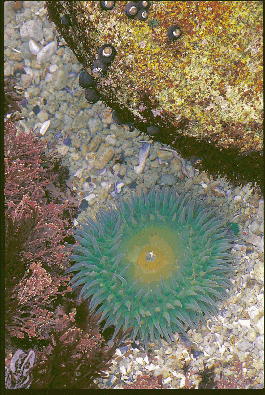|
Related Articles:
Conversations
with a tide pool | Monterey
Memory

Through a fissure
"There
are good things to see in the tide pools and there are exciting and interesting
thoughts to be generated from the seeing. Every new eye applied to the
peep hole ╔ may fish in some new beauty and some new pattern, and the
world of the human mind must be enriched by such fishing." -- John
Steinbeck

 Fans
of John Steinbeck will know that the novelist had an abiding love for
the sea and its occupants. A native of the Monterey Bay area, his observations
of life there make an interesting side note to the story about Willis
Hewatt's research. For Hewatt was a contemporary of Steinbeck -- and met
him at least once while at Stanford. Fans
of John Steinbeck will know that the novelist had an abiding love for
the sea and its occupants. A native of the Monterey Bay area, his observations
of life there make an interesting side note to the story about Willis
Hewatt's research. For Hewatt was a contemporary of Steinbeck -- and met
him at least once while at Stanford.
Ed Ricketts,
a good friend of Steinbeck's and basis for the character Doc in Steinbeck's
Cannery Row, lived only a couple of blocks north of Hopkins Marine
Station. It was an industrial zone filled with sardine canneries and a
class of somewhat seedy workers who kept the businesses in business.
Doc Ricketts,
as he was known, was a college dropout but still became such as expert
in his field that even against outrage by the more "scientific" community,
Stanford printed his Between Pacific Tides in 1939. This detailed
tome of the tidal zone came to be known as the marine biologist's bible.
It is fairly safe to assume that Willis and Ricketts had at least a few
conversations about their similar interests.
Steinbeck,
in the forward to Between Pacific Tides, shared this observation about
such pursuits. And such men:
"The
process of rediscovery might be as follows: a young, inquisitive, and
original man might one morning find a fissure in the traditional technique
of thinking. Through this fissure he might look out and find a new external
world about him╔
"From this
nucleus there would develop a frantic new seeing and a cult of new seers
who, finding some traditional knowledge incorrect would throw out the
whole structure and start afresh. Gradually the structure would be complete
╔ and no one would look beyond it -- until one day a young, inquisitive,
and original man might find a fissure in the pattern and look through
it and find a new world.
"In the
laboratories, fissures are appearing in the structure of our knowledge
and many young men are peering excitedly through at a new world. There
are answers to the world questions which every man must ask, in the little
animals of the tide pools, in their relations one to another, in their
color phases, their reproducing methods. One can live in a prefabricated
world, smugly and without question, or one can indulge perhaps the great
human excitement: that of observation to speculation to hypothesis."

Top
|



